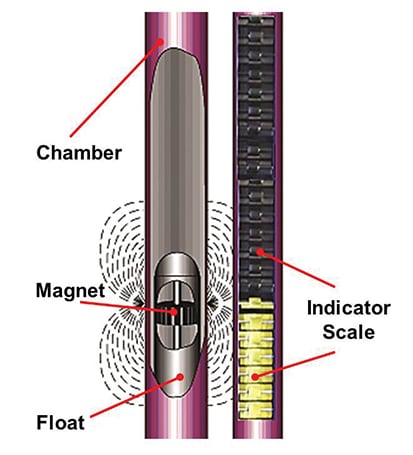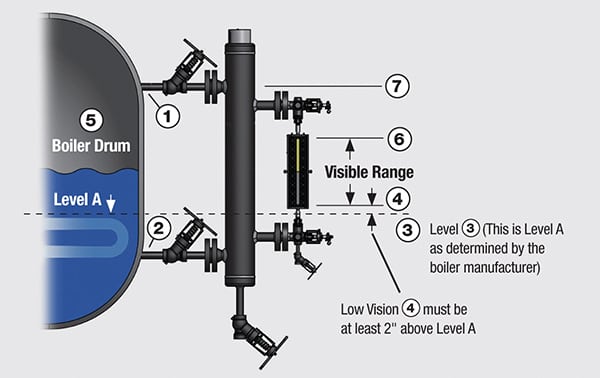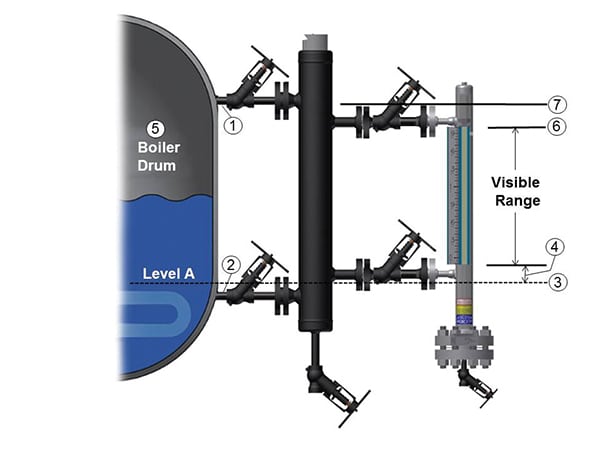Understanding Boiler Code Compliance and Magnetic Level Gages
A magnetic level gage may be an excellent addition to a power plant boiler’s drum-level instrumentation. However, before any changes are made, owners must first understand the specific minimum requirements for water level instrumentation defined by the American Society of Mechanical Engineers (ASME) Boiler and Pressure Vessel Code.
The code requires a functional water gage glass on all boilers, and it must be in service at all times on applications operating up to 400 psig. For boilers operated at greater pressures, the ASME code permits the minimum use of two remote (indirect reading) level indicators on continuous display for the operator combined with a water gage glass. The use of a magnetic-type level indicator has a code limit of 900 psig.
Furthermore, when two remote indicators are in service, the gage glass may be isolated, but it must be kept in good working condition. Gage glasses are often used to confirm the actual water level in the drum and for comparison with other instruments, especially during startup.
Reliable and Accurate Indication
In most modern installations, the boiler operator is stationed in a control room. The boiler drum gage glass is rarely within the individual’s line of sight. To address this situation, the code allows the use of remote gages, but it requires two independent level indicators to be on continuous display, as previously mentioned. The redundancy provides validation and confidence in this very important level information.
Clark-Reliance—a leading supplier of boiler level indication and control equipment—recommends using multiple technologies for remote indicators to reduce the risk of common mode failure between systems. The most common technologies used for remote water level indication instruments on power boilers are conductivity probes, differential pressure transmitters, guided-wave radar systems, and magnetic level sensors.
Magnetic level gages are composed of a stainless steel chamber with an internal float containing a magnet that causes the externally mounted indicator to respond to changes in water level in the boiler (Figure 1). They may be equipped with a transmitter to detect, transmit, and display the level information for the operator in the control area. However, any water level sensing device that is externally mounted and relies on conductivity, signal detection and transmission, or magnetic sensing technology is considered to be a remote (indirect) type level indicator. A gage glass is the only type of direct-reading level indicator.
ASME Code Requirements
Successful installations require attention to detail. When specifying and installing a magnetic level gage on a power boiler application, the ASME code requirements are very specific with respect to the position limits of the indication scale relative to the vessel connections.
The indication range must meet the same requirements as a gage glass (Figures 2 and 3). These ASME Section 1 code requirements are significantly different when compared to the vast majority of magnetic level gages installed on applications other than power plant boilers.
In Figures 2 and 3, the numbers shown correspond to the following parameters:
- The low side of the outside diameter (OD) of the steam connection outlet on the boiler drum.
- The upper side of the OD of the water connection outlet on the boiler drum.
- The danger point as determined by the boiler manufacturer. This corresponds with level A.
- The level 2 inches above the danger point. (This is the lowest permissible indication level in a gage glass or magnetic level gage.)
- The boiler drum.
- The upper end of the gage glass or magnetic level gage indication scale.
- Item 1 extended for easier comparison to the visible range.
The following ASME code rules apply to magnetic level gages:
■ The maximum operating pressure cannot exceed 900 psig. This eliminates the concern for deviations in level accuracy on frequent cycling applications at higher-pressure service.
■ The indication scale limitations are between 2 inches above the danger point, as determined by the boiler manufacturer, and the low side of the outside diameter of the steam connection exiting the drum, as identified by locations 1 and 4 in Figures 2 and 3.
■ The attachment of any external switches or transmitters to a magnetic level gage for control functions is prohibited.
■ The use of a magnetic level gage does not replace the code-required gage glass.
■ A magnetic level gage may not be used to function as a water column. Other accessories, such as a gage glass, are prohibited from being attached.
■ Magnetic level gages must be installed with isolation and drain valves.
■ For additional details, refer to subsections PG-12 and PG-60 of the ASME code.
To maximize accurate and dependable service life, periodic (annual) float inspections are recommended in order to remove any potential debris that may collect on it. This reasonable maintenance inspection along with periodic blowdowns of the sensing lines will ensure continued and reliable indication. The quality of the boiler water in an application will affect the frequency of necessary inspections. Applications with high-quality water treatment will require less maintenance.
A magnetic level gage can be a useful instrument to supplement the code-required gage glass for local level indication. Additionally, a transmitter may be attached to provide a signal in the control room for remote indication. However, because it must be installed according to code requirements, it may be helpful to consult with your local product provider, insurance carrier, or boiler inspector to confirm the requirements for drum level instrumentation in your specific location.
—James W. Kolbus is product manager for Clark-Reliance Corp.


